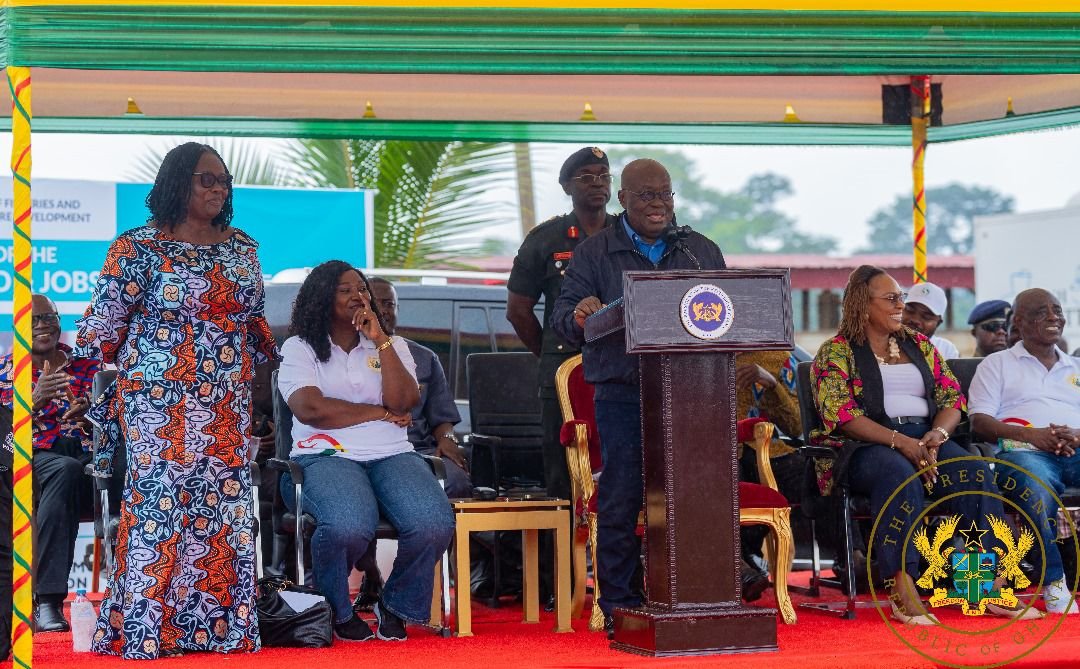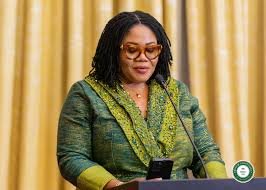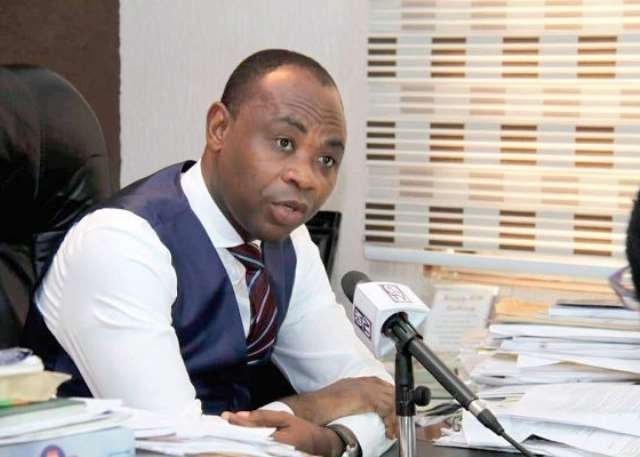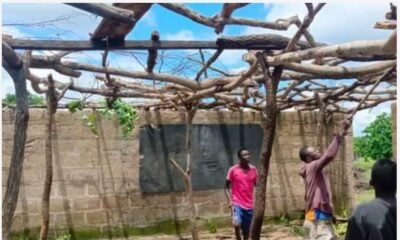News
President Akufo-Addo Launches ‘Aquaculture For Food And Jobs’ Programme: A new dawn for Ghana’s agricultural sector

In a groundbreaking event held on Tuesday, July 30, 2024, at Nsuaem in the Central Region, President Nana Addo Dankwa Akufo-Addo unveiled the Aquaculture for Food and Jobs Programme.
Acknowledging the efforts of the Minister for Fisheries and Aquaculture Development, Hon. Mrs. Mavis Hawa Koomson, President Akufo-Addo praised her dedication and hands-on approach.
Her leadership has been instrumental in developing this project and implementing decisive initiatives such as the annual close season for fishing, which has restored fish stocks and promoted aquaculture as a viable economic sector.
President Akufo-Addo extended his gratitude to all partners, stakeholders, and dedicated teams working to make this project a reality, emphasizing the importance of collaboration in revolutionizing aquaculture in Ghana.
President Akufo-Addo emphasized the immense potential of aquaculture, stating that the sector is a critical component of the global food system.
As the programme was officially launched, President Akufo-Addo called on all Ghanaians to support this initiative, which promises to build a stronger, healthier, and more prosperous nation. “May God bless us all, and our homeland Ghana, and make her great and strong,” he concluded, marking the beginning of a new era in Ghana’s agricultural sector.
This initiative is a testament to the government’s commitment to sustainable development, food security, and job creation.
It marks a significant milestone in the nation’s agricultural sector, aiming to harness Ghana’s abundant water resources to provide sustainable livelihoods and enhance nutritional standards.
Aquaculture currently provides nearly half of the world’s fish supply, a figure that continues to grow as wild fish stocks diminish due to overfishing and environmental changes.
In Ghana, fish is a dietary staple, significantly contributing to the nation’s nutritional intake. However, the domestic supply falls short of the demand, resulting in substantial imports that strain the country’s foreign exchange reserves.
In 2022, Ghana’s fish requirement stood at 1.31 million metric tonnes, while domestic production was only 657,000 tonnes.
This shortfall necessitated the importation of 650,000 tonnes of fish, costing $311 million.
The Aquaculture for Food and Jobs Programme aims to bridge this gap by boosting local fish production, thereby reducing dependence on imports, conserving foreign exchange, and ensuring the availability of fresh, domestically-produced fish.
The programme’s impact extends beyond increasing fish production. It is poised to transform lives by creating thousands of jobs, particularly for the youth and women.
The initiative will provide training and support to aspiring fish farmers, equipping them with the skills and resources necessary for success.
It will also foster a network of fish farms across the country, enhancing Ghana’s capacity to meet the growing demand for fish and stimulating the development of related industries such as fish feed production, processing, and marketing.
By making fish more accessible and affordable, the programme will combat malnutrition and improve public health. Fish is a rich source of essential nutrients, and increasing its availability will significantly contribute to the nation’s nutritional standards.
This initiative is not only an economic driver but also a vital component in the fight against malnutrition.
The programme is being launched in partnership with R&B Farms Ltd., the largest inland fish farm in Ghana, operating on 26 hectares of land in Gomoa Central. Under this project, the government aims to train 10,000 youth in small-scale fish farming.
The ripple effect of this initiative is expected to generate an additional 50,000 jobs along the aquaculture value chain, encompassing fish feed production, equipment supply, fish processing, marketing, and distribution.
President Akufo-Addo called on private investors to seize the opportunities presented by this programme, highlighting the substantial market for fish and fish products.
With the right investments, the aquaculture sector can be transformed into a major economic driver.
Research institutions and universities will play a crucial role in providing the knowledge and technological innovations needed to enhance productivity and sustainability.
Under this programme, the government will provide youth with training and skills development in fish farming.
They will receive tarpaulin cages, fingerlings, and fish feed as seed capital, enabling them to start profitable fish farming businesses within six months.
The launch of the Aquaculture for Food and Jobs Programme signifies a bold step towards a brighter future for Ghanaian youth and women.
It aims to meet fish consumption needs, reduce import dependency, and provide meaningful employment.
News
‘Stop shielding perpetratorsof Gender-Based Violence’By Spectator Reporter

THE Minister of Gender, Children and Social Protection (MOGCSP), Dr Agnes Naa Momo Lartey, has called on traditional authorities, religious leaders and community influencers to stop shielding perpetrators of gender-based violence and allow the law to work.
She said too many cases were being buried at the community level, with abusers protected while victims were pressured into silence. This, she stressed, must end.
Dr Lartey made the call on Tuesday at the national launch of the 2025, 16 Days of Activism Against Gender-Based Violence campaign, held at the Kaneshie Main Station in Accra.
This year’s campaign, observed globally from November 25 to December 10, is on the theme: ‘Unite! End Digital Violence Against Women and Girls.’
It highlights rising incidents of cyberbullying, online stalking, image-based exploitation and other forms of technology-facilitated abuse that disproportionately affect women and girls.
The minister urged the media to use their platforms to condemn abuse and intensify education, noting that no person should “die in silence’’ in a society that values dignity, equality and the principles of Sustainable Development Goal 5.
She also encouraged women, girls, men and boys to report any form of abuse, assuring the public that support services were available to all, regardless of age or social status.
Dr Lartey described gender-based violence as one of the most pervasive human rights violations in Ghana. She referenced a 2016 Domestic Violence Survey showing that 27.7 per cent of Ghanaian women have experienced domestic violence, as well as a 2014 Demographic and Health Survey which revealed that 32 per cent of girls aged 15–24 believe wife beating was justified—an indication of harmful societal norms.
Calling the situation “unfortunate and sad,” she stressed that the nation must dismantle cultural beliefs that excuse or normalise violence.
Outlining government actions, Dr Lartey announced that Cabinet has approved the revised National Domestic Violence Policy, while the updated Domestic Abuse Bill and its Legislative Instrument were being finalised by the Attorney-General’s Department.
She also disclosed plans to operationalise a national shelter in Accra and begin constructing the 16 regional shelters promised to strengthen protection systems for survivors.
Additionally, the ministry has trained 200 market leaders as paralegals and 100 professionals, including psychologists, medical workers and legal experts, to support victims with referrals and counselling.
UNFPA Country Representative, Dr David Wilfred Ochan, reaffirmed the agency’s support for Ghana’s efforts. He unveiled a nationwide initiative titled “16 Stations, 16 Routes, 16 Destinations,” which will use the country’s public transport system to raise awareness on gender-based violence.
In partnership with the Ghana Private Road Transport Union (GPRTU), the initiative will promote stickers, public announcements, training and codes of conduct to ensure that transport stations become safe spaces where commuters, traders, porters and young people can access information and hotline services to report or prevent abuse.
Join our WhatsApp Channel now!
https://whatsapp.com/channel/0029VbBElzjInlqHhl1aTU27
News
Safeguard religious rights ofstudents – CRI urges studentsBy Spectator Reporter

CHILD Rights International (CRI) is urging the government to adopt a firm and comprehensive national policy to safeguard the religious rights of students in secondary schools, insisting that no child should be denied education or the freedom to express their faith.
In a statement issued on Thursday in Accra, the organisation said the recent controversy involving Wesley Girls’ Senior High School highlights deep-seated gaps in how children’s rights were upheld within the country’s long-standing educational structures.
According to CRI, the incident underscores the need for Ghana to reassess the relationship between school traditions and the constitutional rights of students.
The group emphasised that the right to education and the right to religious expression were fundamental, and must be reflected consistently in rules and practices across all schools.
Additionally, CRI noted that many well-known mission institutions such as Holy Child School and St. Louis Senior High School operate on religious foundations that have shaped their administrative cultures for decades.
These differ significantly from state-established schools like Ghana Senior High School in Koforidua, Tamale Senior High School and Achimota Senior High School.
This contrast, CRI argued, raises an important national question and what policy framework has guided these mission schools since their incorporation into the public system?
Although the government has declared all such schools secular, they continue to function as government-assisted institutions, maintaining a hybrid structure that leaves them neither fully autonomous nor entirely under the Ghana Education Service (GES).
This unclear arrangement has led to inconsistent rules on discipline, conduct and religious expression from one school to another.
CRI warned that the absence of a unified and enforceable national policy leaves significant gaps in the protection of children’s rights.
While rights may be universal, the group emphasised that their protection depends on strong and clearly defined state regulations.
The organisation further stated that the State has yet to assume full regulatory authority over the schools it supports financially. As a result, key administrative and disciplinary decisions often remain at the discretion of individual school authorities, creating uneven standards nationwide.
For the rights of children, particularly their right to practise their religion to be fully realised, CRI believes the government must move toward full regulatory ownership of all schools it funds or classifies as public.
Without this, tensions between deeply rooted school traditions and constitutional freedoms are likely to persist.
The statement stressed that once a school admits a student, it takes responsibility not only for their academic development but also for respecting their identity, including their religious background. Therefore, no child, CRI insists, should be prevented from practicing their faith within the school environment.
Moreover, the organisation called for the establishment of clear national standards that guide schools on accommodating religious expression without compromising discipline or institutional order.
It also urged the government to strengthen safeguarding systems with firm oversight and routine monitoring to ensure that children’s rights are protected based on national law, not historical customs or administrative discretion.
CRI admonished the government to clarify the official status of government-assisted mission schools to ensure that the rights of all students are upheld consistently across the country.
By Spectator Reporter
Join our WhatsApp Channel now!
https://whatsapp.com/channel/0029VbBElzjInlqHhl1aTU27















